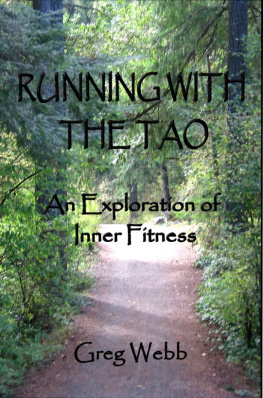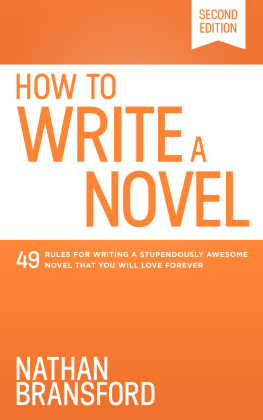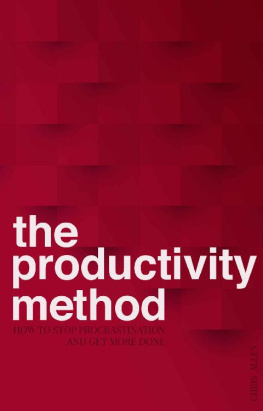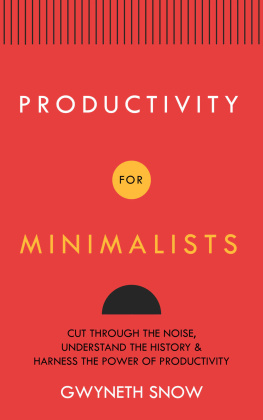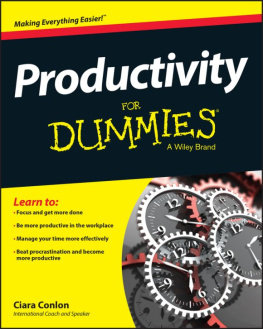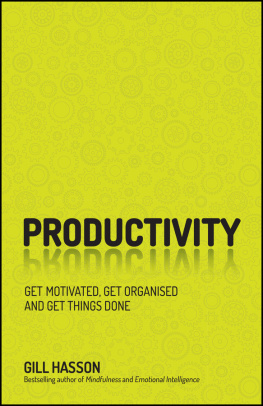Part One
Change Your Mindset
Introduction
The Missing Link in Productivity Systems
D o we truly need another book on productivity? Well, if the number of people who tell me theyre busy when I ask them how they are is any indication, we do. Busy is the new default, but it doesnt have to be.
If you are reading this book, you may be looking for an extra edge to make you more productive. Or maybe you purchased the book because you are overwhelmed by requests for your time, and you are not sure how to respond. Maybe you are looking for more balance in your work and home life. Maybe you want to figure out how to deal with your never-ending to-do list. You have likely tried many other productivity systems before and found that some work, some dont. Maybe you feel like theres still something missing in your system.
I wrote this book for those who struggle with too much to do and who believe they dont have enough time to do it. Ive been reading productivity books and studying productivity for thirty years, and what I have learned in my quest to understand the secrets of the most productive people is that there is a missing link in current productivity systems. The authors tell people how to manage their projects or to-do lists, but they dont discuss the fact that to-do lists on their own dont work. Why dont they work? Because our brains are hardwired to get in the way of being productive, and the result is that were constantly busy rather than purposely productive. Existing productivity tools and advice either help us manage what is already on our list or help us organize the list in a way that helps us execute it. We need a system to determine what gets put on our plate in the first place. As the title of this book suggests, the missing link in productivity systems is knowing when to say yes.
In his book When, Dan Pink discusses the secrets of perfect timing. He uses research from psychology, biology, and economics to explain the best time to do certain things like switch careers or quit a job. He forecasts a new trend toward when-to books rather than how-to books. In this book, youll learn when to say yes to requests for your timeand when to say no.
My personal quest to understand the mindset of the most productive people unknowingly began in 1989, when I took a two-day personal productivity seminar called Managing Actions and Projects ( MAP ) delivered by guru David Allen. I swaggered out on the final day feeling enthusiastic, joyful, and excited, as if I could accomplish anything and there was nothing standing in my way. A colleague of mine had recommended the seminar early in my software-development career, and it fueled my hunger for performance improvement. During the seminar, I learned some of the important basic ideas of personal productivity, such as how to manage a calendar, how to create action lists, and how to organize a reference system.
After the seminar finished on Friday afternoon, I went back to my cubicle and stayed late so I could implement everything I had learned. First, I tackled the piles of paper on my desk. Each pile had a purpose, and within each pile were buried incomplete tasks and unresolved commitments. With each scrap of paper, I made a decision on the next action required, where to file it, or whether to trash it. I labeled every file folder, sorted them alphabetically, and stored them neatly in my file drawer. I set up three stacking letter traysthe top one for inbox, the middle one for pending, and the bottom for filing. I created one place to document all my projects and commitments.
When I was finished, there was nothing on my desk except for my computer, my stacking trays, and a picture of my car. I sprayed it and scrubbed it all down. I left four hours later with a clear mind and an empty plate, feeling completely current and ready to conquer the world. Clear desk, clear mind.
What I learned in MAP served me well in my corporate career and allowed me to advance to senior technology positions. The skills enabled me to remain calm in the midst of a crisis. The ability to know whats important, what must be done today, and what can be deferred in the moment is critical. If we are trying to manage emergencies at the same time were thinking about responding to Bill and calling Amy, our attention will be diverted.
When I worked at Fidelity Investments between 1987 and 2008, there was a culture of figuring out how to do it, whatever it was. As a software solutions provider, my teams knew it was never acceptable to tell our customers, No, we cant do it. Rather, it was a discussion about priorities, or a trade-off between time and other factors. So, the more appropriate response was, We can do that, and we will need more time, or, We can do that instead of feature x. A good software project manager will prioritize time, quality, cost, and functionality as part of the project charter. When you take this approach with your business customers, you create an environment that opens up dialogue, builds credibility, and fosters strong partnerships.
In addition to what I learned in the corporate world, I continued to ask myself: What makes some people more productive than others? Seeking a clear answer, I decided to pursue a PhD in human and organizational systems with a focus on personal productivity. Okay, youve got to admit, thats pretty geeky. Im not finding the answers I want, so I go spend five years of my life becoming a PhD. A bit overboard maybe. However, I enjoyed this journey for a number of reasons: It was challenging and fulfilling, and I connected with amazing people I call friends today. And its where I learned that it is not at all about the goal; it is about who you become in achieving the goal.
I also learned this lesson from talking directly with highly productive people. I wanted to understand their mindset, so I interviewed chief information officers ( CIO s) and chief technology officers ( CTO s) around the United States and asked them how they evaluated requests for their time. CIO s and CTO s have the most senior technology roles in organizations. One doesnt get to be the most senior tech person without some level of self-management and focus on productivity. They are highly successful by at least one measure (career), and thats certainly not the only measure. Each of them spent ninety minutes total completing a one-on-one interview with me and a trusted self-assessment that addresses goal setting, priorities, planning, scheduling, time management, and organization. During the interviews, and as I analyzed the transcripts after, I investigated how participants experienced requests for their time. I asked questions like the following:
- What type of requests are made of you?
- How do you manage these requests?
- What was your thought process when saying no?
- How did you process two requests that were both critical?
- Describe a situation where you had no choice but to say yes.
What is encouraging is that the empirical data from the self-assessment supported the qualitative data from the interviews.
It was through these interviews, and as an executive coach and entrepreneur leading a team of coaches, that I discovered the missing link. I heard clearly from midlevel executives that they have difficulty saying no, and I think this is true of many people. In fact, leaders prefer not to say no. They associate more pain with saying no today than they do with the potential pain of having too much to do later. I very seldom say no, because no just upsets people and puts them on the defensive, one exclaimed. It is hard for me to say no; I would rather figure out how to do something, said another. One thing I never think about is, do I have permission to say no? Id rather figure out how to do something, said yet another.



